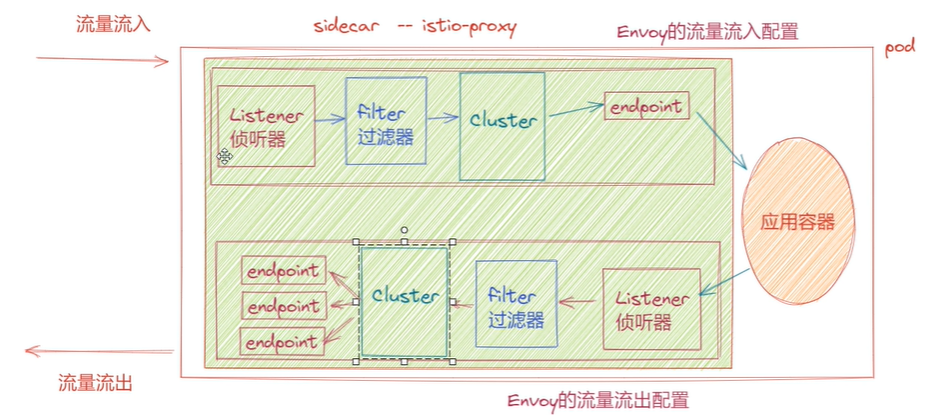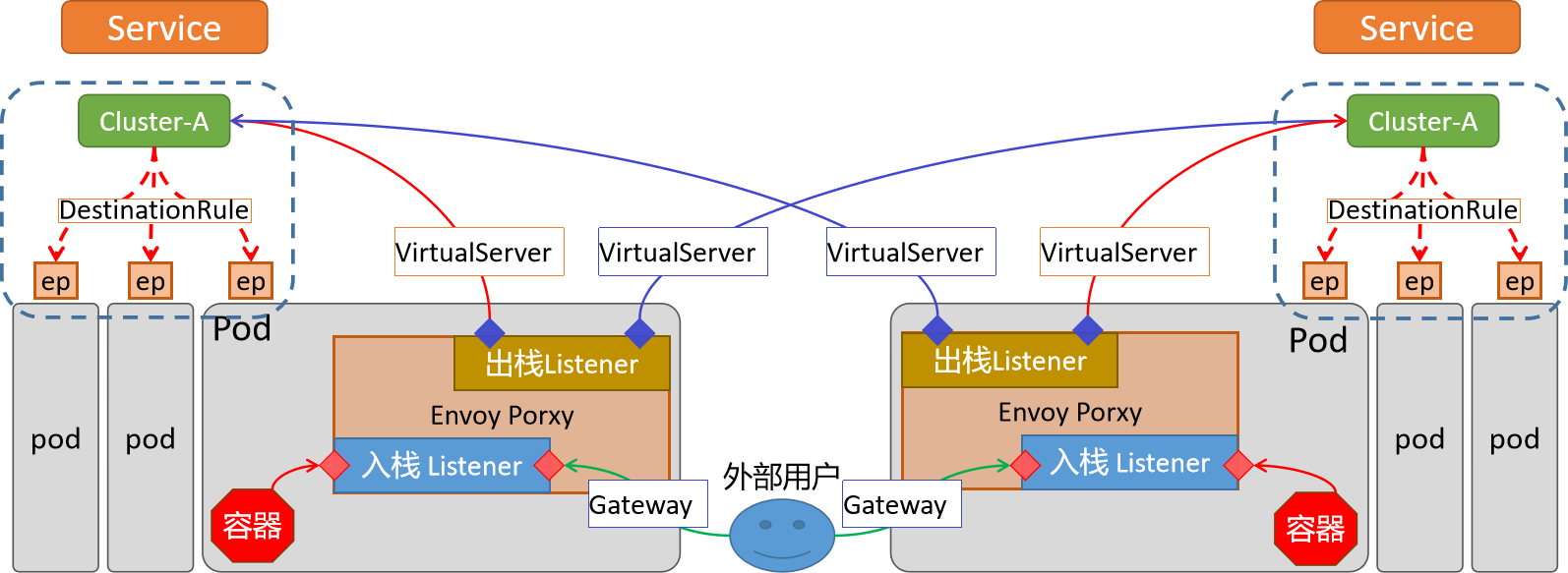lstio
目录
简介
lstio 应该是现在的服务网格事实标准.
概念速览
功能介绍
- 流量管理:负载均衡,动态旅游,灰度发布
- 可观察性:调用链,访问日志,监控
- 策略执行:限流,ACL
- 安全:认证和鉴权
基础架构
随着版本变化,组件能力的加强,降低复杂性,基础架构慢慢简化。
- 数据层面:envoy
- 控制层面:Istiod
- Pilot:转换规则,下发规则到 proxy。主要是服务发现的规则,以及流量的管理。提供了 a/b 测试,金丝雀发布。弹性(超时,重试,熔断)
- Mixer:接管流量。每次 proxy 之间的请求,都会上传和报告。所以可以控制访问,以及收集遥测数据。主要是因为 envoy 功能的增强,很多功能整合到了 envoy,所以 mixer 功能变少。
- Citadel:服务间的安全认证。例如双向 tls 的安全
- Galley:Istio 配置的管理组件,解耦 istio 与 k8s ,避免强绑定。验证、处理和分发配置信息到各个 Istio 组件。
istio 资源对象/图
相关资源对象:
- Gateway 接受外部流量,相当于 ingress-svc
- VirtualService 定义了流量的路由规则和目标服务。是后端应用的集合,相当于 service。但是这个 service 对接的是每个 pod 里的 sidecar,而不是容器
- cluster, endpoint, filter 等内容属于 envoy 内部
其他资源:
- ServiceEntry:应用依赖集群外部服务
- Engress: 正常返回之类的流量
- EnvoyFilter:控制 envoy 中的 filter 规则
- DestinationRule: 一些规则,流量经过了 filter 后如何到达容器(负载均衡,连接池的大小,请求失败或者错误以后的重试和故障转移,tls 设置等)
istioctl
安装
- 下载 Releases · istio/istio
tar xf istio-1.20.0-linux-amd64.tar.gzvim ~/.bashrc添加 bin 目录到 PATH 变量export PATH=/root/istio-1.20.0/bin:$PATH
istioctl 概念和命令
istioctl 由核心 core 与插件 addons 组成。不同的应用场景,就是不同插件的组合。
常见组件:
istio coreCRD 之类的istiod控制平面ingress/egress gateway出入网关
初始命令:
istioctl profile list查看所有组合。每个组合对应manifests/profiles下面的一个 yml 文件。demo比较完整。有采集指标,适合演示default默认适合生产环境minimal仅部署控制平面preview更高级别 demo,新功能尝鲜istioctl profile diff demo empty查看 2 个配置的区别
istioctl manifest generate --set profile=demo生成 yml 文件istioctl install--set profile=demo选择配置--set xxx.xxx.xxx=true修改某个 profile 的值-f xxx.yml自定义指定 yml
常用操作命令:
- 检测是否正常
istioctl analyze -n default检测 xxx 空间是否正常注入istioctl experimental precheck检测更新,部署,调整后控制平面是否正常
- 卸载
istioctl uninstall -f demo.yml或istioctl uninstall --purge - 端口代理
istioctl dashboard --address 0.0.0.0 kiali - 代理查询
istioctl proxy-status
一些可能用上的 yaml,可以用来展示流量用:
kubectl apply -f samples/addons/grafana.yaml
kubectl apply -f samples/addons/prometheus.yaml
kubectl apply -f samples/addons/kiali.yaml
kubectl apply -f samples/addons/extras/zipkin.yamlenvoy
关键组件
- listener:做为流量入口,监听一个
ip:port,可以代理 tcp,http,gRPC 之类的流量 - filter:处理进出 envoy 的流量。修改,转换,拦截,响应。还可以路由,权限检查。
- route:根据请求信息,指定使用哪一个 cluster
- cluster: 是 envoy 用来描述后端的一个逻辑集合。cluster 是通过
k8s-service创建出来的一个对象。 envoy 通过 cluster 得知如何连接到特定服务 - endpoint:cluster 中的一个实例。通常是一个服务实例的
ip:port. envoy 通过服务发现来动态了解 endpoint
envoy 流量图
- xDS 的 x 指某个资源,DS 是服务发现的意思
- 监听器 LDS
- 集群 CDS
- 端点 EDS
- 路由 RDS
- 图中 filter 是由 EnvoyFilter 创建。其他资源信息都来自于 xDS。例如 filter 后的 Route 和 Proxy 就是来自于 RDS
graph TD
A[Client] -- Request --> B(Envoy Listener)
B --> C{Envoy Filter Chain}
C --> |HTTP Filter| D[Envoy HTTP Route]
C --> |TCP Filter| E[Envoy TCP Proxy]
D --> F[Envoy Cluster]
E --> F
F --> G[Load Balancing]
G --> H{Endpoint Selection}
H --> I[Service Pod 1]
H --> J[Service Pod 2]
H --> K[Service Pod N]
style A fill:#f9f,stroke:#333,stroke-width:2px
style I fill:#ccf,stroke:#333,stroke-width:2px
style J fill:#ccf,stroke:#333,stroke-width:2px
style K fill:#ccf,stroke:#333,stroke-width:2px
单个 pod 内的流入流出:
- 上面流入的流程没有变化
- 但是流出的流量,可能是其他 service。所以流出的 cluster 不一定是同样的
ip:port

同服务/跨服务流量图:

sidecar 注入实践
初始验证
# 安装istio的demo方案
istioctl install --set profile=demo
# 加上标签,开始自动注入
# 删除 istio-injection-
# 覆盖 --overwrite
kubectl label namespace default istio-injection=enabled --overwrite
# 确认打上了标签
kubectl get namespaces default --show-labels
# 创建容器
kubectl create deployment my-nginx --image=nginx:latest
# 验证
# 发现多个pod和很多内容
kubectl get po
kubectl describe pod my-nginx-86d74cfc8f-5wvjn手动注入 envoy
yaml 解读:
- 创建命名空间
- 创建 envoy 配置文件
admin.address是管理面板地址,html 页面观测static_resources.listeners.address是 pod 中 envoy 监听的端口,请求这个地址都会被 envoy 接管filter_chains中配置了 http 代理功能,同时指定接管的流量指向 local_clusterlocal_cluster的端口是 80,也就是我们 nginx 容器的默认端口
- 创建 pod 并挂载 envoy 配置文件。必须指定 2 个变量环境,envoy 才能正常监听 80 端口。
apiVersion: v1
kind: Namespace
metadata:
name: kentxxq
---
apiVersion: v1
kind: ConfigMap
metadata:
name: envoy-sidecar-configmap
namespace: kentxxq
data:
envoy.yaml: |
admin:
address:
socket_address: { address: 0.0.0.0, port_value: 8001 }
static_resources:
listeners:
name: listener
address:
socket_address: { address: 0.0.0.0, port_value: 8002 }
filter_chains:
- filters:
- name: envoy.filters.network.http_connection_manager
typed_config:
"@type": type.googleapis.com/envoy.extensions.filters.network.http_connection_manager.v3.HttpConnectionManager
stat_prefix: ingress_http
codec_type: AUTO
# 启用http代理的路由功能
http_filters:
- name: envoy.filters.http.router
# 一定要设定该typed_config属性,否则提示无法找到router
typed_config:
"@type": type.googleapis.com/envoy.extensions.filters.http.router.v3.Router
# 定制router配置
route_config:
name: tomcat_route
virtual_hosts:
- name: tomcat_web
domains: ["*"]
routes:
- match: { prefix: "/" }
route: { cluster: local_cluster }
clusters:
- name: local_cluster
type: STATIC
lb_policy: ROUND_ROBIN
load_assignment:
cluster_name: local_cluster
endpoints:
- lb_endpoints:
- endpoint:
address:
socket_address: { address: 127.0.0.1, port_value: 80 }
---
apiVersion: v1
kind: Pod
metadata:
name: tt-sidecar
namespace: kentxxq
spec:
containers:
- image: kubernetes-register.sswang.com/mypro/envoy:v1.25.3
name: envoysidecar
env:
- name: "ENVOY_UID"
value: "0"
- name: "ENVOY_GID"
value: "0"
volumeMounts:
- name: envoyconf
mountPath: /etc/envoy/
readOnly: true
- name: nginx-demo
image: nginx:latest
volumes:
- name: envoyconf
configMap:
name: envoy-sidecar-configmap
optional: false验证:
# 可以正常请求到nginx容器的80端口
curl cluster-ip:8002官方注入流程文档 Istio / Installing the Sidecar
容器解读
容器注入和启动
常见问题:
- sidecar 如何接入流量?初始化动作,实现容器网络和 sidecar 网络一致
- 访问 pod 的流量,怎么给 proxy?定制大量防火墙规则
- 流量接管的规则从哪来?istiod 的 pilot 分发
流程:
- 先部署 istiod(galley,pilot)
- 用户提交 yaml,被 pilot 监听到
- 使用 istio-init 初始化动作,配置防火墙
- intio-proxy(sidecar):拉取配置,处理流量。内部有 pilot-agent 和 envoy
- pilot-agent 和 istiod/polit 建立连接,拿到配置后转换成 envoy 配置。同时这个连接不会关闭,一旦出现变更 istiod/polit 可以主动推送变化
- 启动 envoy
课件版:
1 基本环境状况
istio构建于k8s集群之上,所有的请求都是基于k8s的apiserver组件来接收
2 接收请求
当用户发起一个请求(通过namespace自动注入sidecar或者手工kube-inject注入sidecar)
3 流程执行
Pilot 监听 kube-apiserver 的请求变化。
发现k8s创建请求,并且发现namespace包含注入标签或者手工kube-inject注入sidecar
istio通过CRD对象,经由kube-apiserver对pod进行属性修改,添加大量sidecar相关的属性信息
- 扩充istio-init、istio-proxy等容器属性
pod启动时候,kubelet 调用cri-服务创建容器服务
- 首先启动istio-init初始化应用容器,设定大量的proxy代理需要的防火墙规则
- 初始化容器使命结束后,结合大量启动参数,拉起istio-proxy容器(因为他们是同一个镜像)
- istio-proxy容器内部的pilot-agent 进程从 Pilot中获取流量策略配置
- pilot-agent 把获取的配置转换成Envoy识别的规则,然后通过启动参数,拉起Envoy服务
- Envoy 作为sidecar,根据转换后的规则对pod内部的所有流量进行管控
- 启动应用服务容器,受sidecar的流量策略监管。
4 数据聚合
istio-proxy对多有的流量数据、日志数据、检测数据、遥测数据进行聚合
所有的内部应用容器的检测通过istio-proxy上的15020进行检测
pilot-agent与istio的pilot等组件实时同步相关信息
注意:
关于istio-proxy和应用容器的启动顺序由配置文件内部的顺序决定
但是应用容器的服务检测,必须通过istio-proxy检测后,才会向外表示正常容器内部信息
pod 内部存在 app 和 sidecar
- 两个容器 ifconfig 的 ip ,网卡完全一致。(初始化容器干的)
- 会出现很多监听的端口:
- 15000,15001,15006,15021,15090 都是被 envoy 进程所管理的
- 15004,15020 是被 pilot-agent 进程管理的
kubectl logs -f -n istio-test pod名称 -c istio-init- PROXY_UID=1337, PROXY_GID=1337,
- 容器内输入
id 1337,可以看到所有流量被 istio-proxy 用户接管 uid=1337(istio-proxy) gid=1337(istio-proxy) groups=1337(istio-proxy)
- 容器内输入
- ISTIO_IN_REDIRECT 15006 监听所有流量进入
- ISTIO_REDIRECT 15001 监听流出地址
- PROXY_UID=1337, PROXY_GID=1337,
istio 的端口,作用说明 Istio / Application Requirements
istio 资源使用实践
测试客户端
准备一个测试客户端,后面的 curl 都会在这里进行测试
apiVersion: apps/v1
kind: Deployment
metadata:
labels:
app: client
name: client
namespace: istio-traffic-test
spec:
replicas: 1
selector:
matchLabels:
app: client
template:
metadata:
labels:
app: client
spec:
containers:
- image: busybox:v0.1
name: client
command: ["/bin/sh","-c","sleep 72000"]基础使用
创建
- 新的命名空间
istio-traffic-test - http 运行容器
httpd1和httpd2 web-svc,httpd-1-svc和httpd-2-svc
apiVersion: v1
kind: Namespace
metadata:
name: istio-traffic-test
---
apiVersion: apps/v1
kind: Deployment
metadata:
labels:
server: httpd1
app: web
name: httpd1
namespace: istio-traffic-test
spec:
replicas: 1
selector:
matchLabels:
server: httpd1
app: web
template:
metadata:
labels:
server: httpd1
app: web
spec:
containers:
- image: busybox:v0.1
name: httpd
command: ["/bin/sh","-c","echo 'HTTP Web Page-1' > /var/www/index.html; httpd -f -p 8080 -h /var/www"]
---
apiVersion: apps/v1
kind: Deployment
metadata:
labels:
server: httpd2
app: web
name: httpd2
namespace: istio-traffic-test
spec:
replicas: 1
selector:
matchLabels:
server: httpd2
app: web
template:
metadata:
labels:
server: httpd2
app: web
spec:
containers:
- image: busybox:v0.1
name: httpd
command: ["/bin/sh","-c","echo 'HTTP Web Page-2' > /var/www/index.html; httpd -f -p 8080 -h /var/www"]
---
apiVersion: v1
kind: Service
metadata:
name: httpd-1-svc
namespace: istio-traffic-test
spec:
selector:
server: httpd1
ports:
- name: http
port: 8080
---
apiVersion: v1
kind: Service
metadata:
name: httpd-2-svc
namespace: istio-traffic-test
spec:
selector:
server: httpd2
ports:
- name: http
port: 8080
---
apiVersion: v1
kind: Service
metadata:
name: web-svc
namespace: istio-traffic-test
spec:
selector:
app: web
ports:
- name: http
port: 8080使用 VirtualService 真正转发流量,按照权重分配
apiVersion: networking.istio.io/v1alpha3
kind: VirtualService
metadata:
name: web-svc-vs
namespace: istio-traffic-test
spec:
hosts:
- web-svc
http:
- route:
- destination:
host: httpd-1-svc
port:
number: 8080
weight: 20
- destination:
host: httpd-2-svc
port:
number: 8080
weight: 80资源对象之间的关系

VirtualService 详解
VirtualService.spec
apiVersion: networking.istio.io/v1beta1
kind: VirtualService
metadata: # 元数据部分,包括VirtualServer的名称
name: my-virtualserver
namespace: default
spec: # 定义VirtualServer的规则和配置
hosts: # 指定VirtualServer应用的主机名,可以是一个或多个
- example.com # 改地址必须能够被正常访问
gateways: # 指定VirtualServer关联的网关,可以是一个或多个
- my-gateway
http: # 定义HTTP流量的路由规则
- match: # 指定匹配条件,
- uri: # 支持使用URI前缀匹配
prefix: /path/to/url
rewrite: # 定义HTTP流量的路由重写规则
uri: /
route: # 定义匹配条件满足时的路由目标
- destination: # 指定路由的目标服务
host: api-service # 指定目标服务的主机名,可以是k8s的service对象
port: # 指定目标服务的端口号
number: 8080基于 url
- 改写了 url
- 如果都不匹配,有一个默认路由
xxx-svc
apiVersion: networking.istio.io/v1beta1
kind: VirtualService
metadata:
name: traffic-route-rul
namespace: istio-traffic-test
spec:
hosts:
- web-svc
http:
- match:
- uri:
prefix: /app1
rewrite:
uri: /
route:
- destination:
host: httpd-1-svc
- match:
- uri:
prefix: /app2
rewrite:
uri: /
route:
- destination:
host: httpd-2-svc
- route:
- destination:
host: xxx-svc基于权重
apiVersion: networking.istio.io/v1beta1
kind: VirtualService
metadata:
name: traffic-route-weight
namespace: istio-traffic-test
spec:
hosts:
- web-svc
http:
- match:
- port: 8080
route:
- destination:
host: httpd-1-svc
weight: 10
- destination:
host: httpd-2-svc
weight: 90DestinationRule
DestinationRule.spec
- 必须配合 VirtualService 发挥作用
- subsets 有点像 service,通过标签拿到变成一个个 pod 集合。
- 一旦使用 subset 的时候,就相当于使用 subset 的角色来替换,VS 里面默认的 destination.host 属性,所以必须使用 subset 里的名称
apiVersion: networking.istio.io/v1beta1
kind: DestinationRule
metadata: # 元数据部分,包括 DestinationRule 的名称
name: <destinationrule-name>
spec: # 规范部分,定义 DestinationRule 的规则和配置
host: <service-host> # 指定目标服务的主机名
trafficPolicy: # 流量策略配置部分
loadBalancer: # 负载均衡器配置
simple: <load-balancer-configuration> # 指定负载均衡策略,ROUND_ROBIN(轮询)策略。
# 主要是本地级别、轮询级别、http级别
connectionPool: # 连接池配置
http: # 指定 HTTP 连接池配置。
http1MaxPendingRequests: 100 # 每个连接允许的最大挂起请求数
maxRequestsPerConnection: 5 # 指定每个连接的最大请求数。
outlierDetection: # 异常检测配置
consecutiveErrors: 5 # 指定连续错误的阈值。
interval: 5s # 指定检测间隔时间。
baseEjectionTime: 30s # 指定从负载均衡中排除主机的基本时间。
maxEjectionPercent: 50 # 指定最大排除比例。
subsets: # 服务端点集合,用于路由规则中的流量拆分
- name: xxxx
labels: # 使用标签对服务注册表中的服务端点进行筛选
version: v3
trafficPolicy:
loadBalancer:
simple: ROUND_ROBIN # 支持默认的轮询调度
consistentHash: # 支持基于http的相关属性调度。比如httpHeaderName等
httpCookie:
name: user简单示例
apiVersion: networking.istio.io/v1beta1
kind: DestinationRule
metadata:
name: traffic-rule-subset
namespace: istio-traffic-test
spec:
host: web-svc
subsets:
- name: httpd1
labels:
server: httpd1
- name: httpd2
labels:
server: httpd2
---
apiVersion: networking.istio.io/v1beta1
kind: VirtualService
metadata:
name: traffic-route-subset
namespace: istio-traffic-test
spec:
hosts:
- web-svc
http:
- route:
- destination:
host: web-svc
subset: httpd1
weight: 70
- destination:
host: web-svc
subset: httpd2
weight: 30基于 ip 的会话保持
apiVersion: networking.istio.io/v1beta1
kind: DestinationRule
metadata:
name: traffic-rule-subset
namespace: istio-traffic-test
spec:
host: web-svc
subsets:
- name: http-web
labels:
app: web
trafficPolicy:
loadBalancer:
consistentHash:
useSourceIp: trueGateway
Gateway.spec
apiVersion: networking.istio.io/v1beta1
kind: Gateway
metadata: # 元数据部分,包括 Gateway 的名称
name: my-gateway
spec: # 规范部分,定义 Gateway 的规则和配置。
selector: # 选择器用于选择要将流量路由到的 Istio Ingress Gateway
istio: ingressgateway # 选择器标签用于匹配 Istio Ingress Gateway
servers: # 定义 Gateway 监听的服务器配置
- port: # 指定服务器的端口配置
number: 80 # 指定服务器的端口号,这个是istioingressgateway暴露端口
name: http # 指定服务器的名称。
protocol: HTTP # 指定服务器的协议。
hosts: # 指定 Gateway 监听的主机名列表,
- "*" # 这里使用通配符 "*" 匹配所有主机。搭配使用
apiVersion: networking.istio.io/v1beta1
kind: Gateway
metadata:
name: traffic-route-gw
namespace: istio-traffic-test
spec:
selector:
istio: ingressgateway
servers:
- port:
number: 80
name: http
protocol: HTTP
hosts:
- "*"
---
apiVersion: networking.istio.io/v1beta1
kind: DestinationRule
metadata:
name: traffic-route-subset
namespace: istio-traffic-test
spec:
host: "*"
subsets:
- name: httpd-1-svc
labels:
server: httpd1
---
apiVersion: networking.istio.io/v1beta1
kind: VirtualService
metadata:
name: traffic-route-vs
namespace: istio-traffic-test
spec:
hosts:
- "*"
gateways:
- traffic-route-gw
http:
- route:
- destination:
host: web-svc
subset: httpd-1-svc验证:
# 可以看到vs引用的gateway和配置的hosts
kubectl get vs
# 访问测试
curl ingressgateway-clusterIP或者loadbalanceIPSidecar
Sidecar.spec
apiVersion: networking.istio.io/v1beta1
kind: Sidecar
metadata: # 包含了 Sidecar 对象的名称和命名空间
name: my-sidecar
namespace: my-namespace
spec: # 定义了 Sidecar 对象的规范
workloadSelector: # 指定了与 Sidecar 关联的工作负载的标签选择器
labels:
app: my-app
outboundTrafficPolicy: # 定义了 Sidecar 的出站流量策略
mode: REGISTRY_ONLY # REGISTRY_ONLY,表示只允许与服务注册表中的服务进行通信
egress: # 定义了 Sidecar 的出口规则,即允许的外部主机和端口
- hosts:
- example.com # 当前命名空间的 example.com的 service
- "./*" # 当前命名空间下是所有Service
- "istio-system/*" # 匹配istio-system命名空间下的所有Service
ports:
- port: 80
protocol: HTTP
- port: 443
protocol: HTTPS
- hosts: # 其他的访问交给istio-haha命名空间的服务
- "istio-haha/*"
ingress: # 定义了 Sidecar 的入口规则,即允许的入站流量来源和目标
- from:
- namespaceSelector: # 允许来自启用 Istio 注入的命名空间的流量
matchLabels:
istio-injection: enabled
port: # 将其转发到端口号为 8080 的 HTTP 目标
number: 8080
protocol: HTTP
defaultEndpoint: my-service.default.svc.cluster.local # 默认端点实践
仅开放对当前命名空间下的 httpd-2-svc 的访问,而且对于其他应用禁止访问
apiVersion: networking.istio.io/v1beta1
kind: Sidecar
metadata:
name: sswang-sidecar
namespace: "istio-traffic-test"
spec:
workloadSelector:
labels:
app: tomcat
outboundTrafficPolicy: # 定义了 Sidecar 的出站流量策略
mode: REGISTRY_ONLY
egress:
- hosts:
- "./httpd-2-svc.istio-traffic-test.svc.cluster.local"测试客户端 的请求无法联通 httpd-1-svc
curl httpd-2-svc:8080
HTTP Web Page-2
# 下面的无法
curl httpd-1-svc:8080